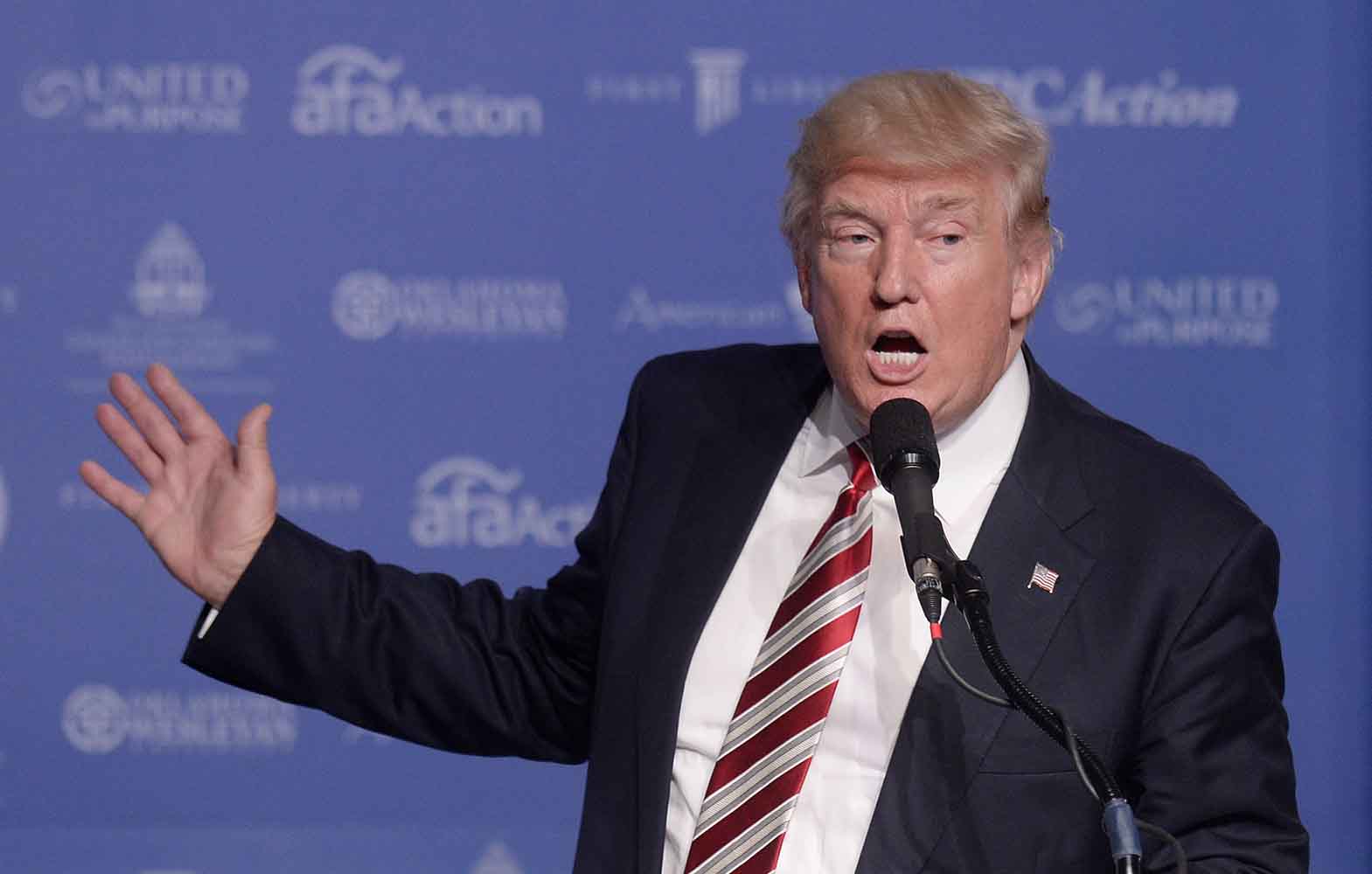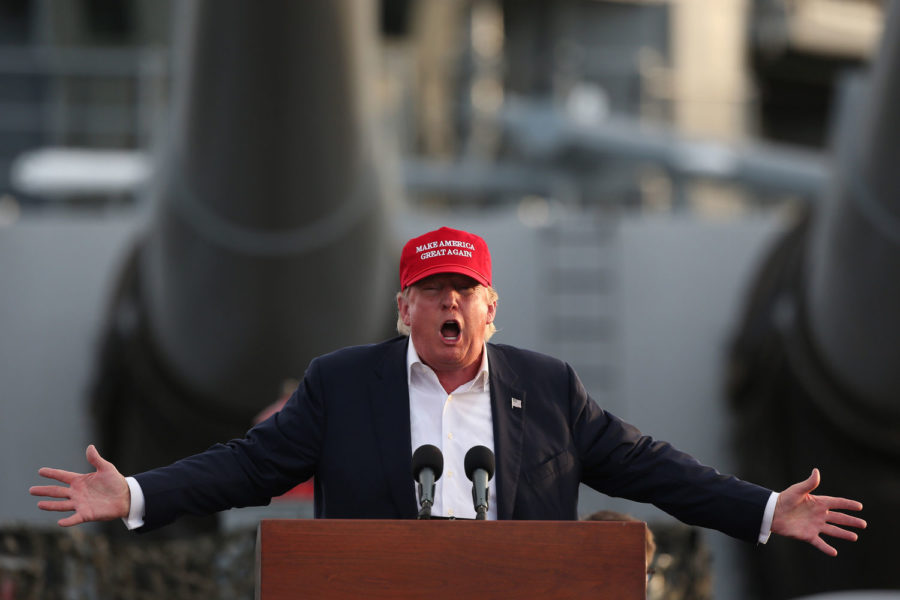President Donald Trump’s America: Lower taxes, higher deficits, fewer immigrants
President-elect Donald Trump speaks to supporters aboard the USS Iowa battleship in Los Angeles on Sept. 15. (Robert Gauthier/Los Angeles Times/TNS)
October 15, 2016
WASHINGTON — It’s fall 2020 and President Donald Trump, who vowed to Make America Great Again in 2016, is promising to make it even greater if he wins a second term. So what has he done?
A fast-food worker at Bojangles’ makes more per hour. Americans have more money from sharp tax cuts, especially the very wealthy. Immigrants from Latin America run into a fence when they try to cross the border illegally. Churches jump openly into politics, without fear of the IRS. Americans also are paying more for Nike shoes, Samsung TVs and some models of Fords.
It costs more to borrow money to buy a car or a house. Young adults are thrown off their parents’ health insurance. Millions of other Americans lose their health insurance, too. Women find it harder — but not impossible — to get abortions. Gays and lesbians can still marry, but they find it harder to adopt children, seek shelter, get tax advice.
Advertisement
Trump would not get everything he proposed during the 2016 campaign through Congress. But this is how America would look if he got his way, based on numerous independent analyses of how his proposals would work on such things as paychecks, prices, immigration, abortion and LGBTQ rights.
Here’s a snapshot of the nation after four years with Trump at the helm.
Taxes
Americans have more money in their pockets after Trump sharply cut taxes.
On average, Americans saw their 2017 federal tax burden fall by $2,940 and their after-tax income grow by 4.1 percent. More low-income Americans pay no income tax at all, although people with several children and single parents who had filed as heads of household pay more because numerous deductions and exemptions were eliminated.
Wealthier Americans are among the happiest with the tax cuts. The top 0.1 percent of earners, who make at least $3.7 million, saw the biggest benefits. They experience an average tax cut of nearly $1.1 million, over 14 percent of after-tax income. Wealthy families gain, too, as the estate tax was abolished.
Companies also pay less. The corporate tax rate has fallen from 35 percent to 15 percent, and multinational corporations are encouraged to repatriate their foreign earnings and are taxed at a generous rate of 10 percent. Prices Consumers are paying more for many imported goods such as Nike shoes, Levi’s jeans, Samsung televisions and some General Motors and Ford automobiles.
Advertisement*
Trump’s new tariffs on goods from China and Mexico, meant to force companies to make those goods in the United States, led U.S. companies to pass those higher costs to consumers.
Mark Zandi, chief economist for Moody’s Analytics, estimated that Trump’s tariffs would raise the prices of all imports by 15 percent, and consumer prices across the board by 3 percent. Investors took a hit in their 401(k) accounts, as many U.S. companies with international operations saw sales hurt by higher prices in the U.S., as well as in China and Mexico, where governments retaliated against U.S. companies and products.
Trump’s tax cuts put the federal debt on a path to grow by $6.2 trillion by 2026 and add another $1 trillion of interest costs on top of that, according to the Tax Policy Center, a nonpartisan research group.
Car loans and mortgages became more costly. The rising costs of imports helped force the Federal Reserve to boost its benchmark interest rate to quell inflation. That, too, puts upward pressure on borrowing costs.

Also, worried about the worsening finances of the federal debt, investors demanded higher interest rates on U.S. government bonds. Rating agencies removed the coveted AAA rating for U.S. debt. Investors feared the United States might default on its debt like Greece or Argentina, something Trump hinted at during the 2016 campaign.
Wages A Bojangles’ server in Charlotte now makes $10 an hour, up from $7.25. Activists had pressed for a $15-an-hour increase, but Trump said he’d leave it up to states to adopt higher minimum wages than $10.
Income is less than it would have been otherwise as workers who are in the U.S. illegally face deportation threats and have gone underground or back to Mexico and Central America. Their absence drags against productivity and thus wage growth, and creates shortages of low-skill workers in states with robust economies such as California and New York.
Health care
The Affordable Care Act is gone.
Nearly 21 million Americans have lost health insurance, according to an analysis by the nonpartisan Committee for a Responsible Federal Budget. More than 80 percent who lose coverage work either full time or part time, and 82 percent have modest incomes but are not poor, according to a report by the Robert Wood Johnson Foundation and Urban Institute.
Repeal erased the mandate for individuals to buy health insurance, the mandate for employers with 50 workers or more to provide it, federal subsidies for about 6 million low-and-moderate-income Americans who buy their own insurance and the requirement that young adults can stay on their parents’ plans until they turn 26.
Anyone can buy health insurance from other states, and everyone now can deduct the cost of their health insurance premiums from their taxable income, saving them money.
Abortion
Women seeking legal abortions find it more challenging.
Keeping his campaign vow, Trump began chipping away at the landmark Roe v. Wade Supreme Court decision, which legalized abortion, by appointing conservative federal judges at all levels.
The move allowed states such as Texas to revisit a law the Supreme Court struck down in June 2016 that dramatically cut the number of abortion clinics in the state.
Immigration
Immigrants — both those arriving legally and illegally — find it tougher to enter the United States.
Trump struggled to force Mexico to pay the $25 billion cost of building a wall between the countries. In the interim, he focused on completing a 700-plus-mile security fence complete with checkpoints and technologically advanced surveillance systems, which had been approved when George W. Bush was president in 2006.
“In the end, I think it will be a beautiful, 750-mile fence that Congress has had on the books for a decade,” said Roy Beck, the executive director of NumbersUSA, a group that advocates strict immigration limits and enforcing existing laws.
MORE: President Hillary Clinton’s America: Tax hikes for the rich, bigger government, cheaper college
Immigrants seeking legal entry into the U.S. undergo greater scrutiny, Trump’s so-called “extreme vetting” largely done by following existing immigration laws.
“You’ll see a slow-down in processing from countries with terrorist activities,” Beck said.
Trump expanded U.S. Immigration and Customs Enforcement. But he didn’t make the bolstered agency the “deportation force” he once promised. Instead, he focused on starting deportation for in those in the U.S. illegally and serving time in U.S. prisons, an estimated 820,000 immigrants, according to the Migration Policy Institute.
Immigrants living in the U.S. illegally also encounter more difficulties finding work as Trump expands E-Verify, the program that helps an employer determine whether an immigrant is eligible to work in the U.S., and creates a tracking system to enforce expired visas.
“It’s a very dark period of American history,” said Angela Kelley, an immigration expert and senior vice president at the Center for American Progress, a left-leaning think tank. “He made communities of color terrified. … You will have people who don’t want to come here … . We won’t get the best and brightest.”
Sexual orientation and identity
Gays and lesbians lost protections after Trump repealed several of Obama’s executive orders. Among those scrapped: orders barring companies that do work with the federal government from discriminating against employees on the basis of sexual orientation or gender identity.
With more conservative Trump courts, governors and state legislatures gained greater power to write laws such as North Carolina’s House Bill 2 requiring transgender people to use the bathrooms corresponding with their genders at birth.
“The prospect for LGBT rights is not good,” said Stephen Engel, chair of politics at Bates College and author of “Fragmented Citizens: The Changing Landscape of Gay and Lesbian Lives.”
The strategy, he said, is to “implement state religious freedom restoration acts” that could allow a baker to say no to making a wedding cake for a same-sex couple or a restaurant to deny an LGBT person a table based on religious convictions.
Churches and religious groups that oppose expanded LGBT rights become more vocal and politically involved after the repeal of the so-called Johnson Amendment, a move that Trump pushed for during the presidential 2016 campaign. The amendment had required charitable groups to refrain from politics to keep their tax-exempt status.
Gregory Angelo, president of the Log Cabin Republicans, said the Trump White House years nonetheless are good ones for the LGBT community because of marriage.
“Marriage is here to stay and Donald Trump recognizes that,” he said.
Supreme Court
The court began swinging Trump’s way after he first filled the vacancy created by the February 2016 death of Justice Antonin Scalia.
With three justices in their 80s at the start of his term, Trump had ample opportunities to pull from his lists of 11 conservative potential nominees, who include Steven Colloton of Iowa, Raymond Kethledge of Michigan, Thomas Hardiman of Pennsylvania and William Pryor of Alabama.
The right-leaning court quickly picked up cases involving mandatory union fees paid by nonmembers and immigration policy, including a Texas challenge to the Obama administration’s policy shielding immigrants here illegally from deportation, which was upheld by an evenly divided court in June 2016.
Anita Kumar, David Goldstein, David Lightman and Michael Doyle contributed to this report.
___
(c) 2016 McClatchy Washington Bureau
Visit the McClatchy Washington Bureau at www.mcclatchydc.com
Distributed by Tribune Content Agency, LLC.
Advertisement









